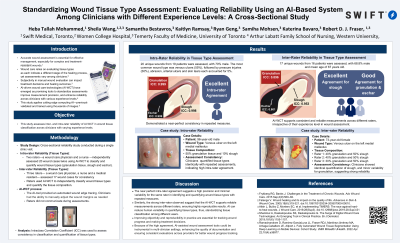Clinical Research
(CR-056) Standardizing Wound Measurement and Tissue Type Assessment: Evaluating Intra-rater Reliability of an Ai-based System Among Clinicians with Different Experience Levels: A Cross-sectional Study
Friday, May 2, 2025
7:45 PM - 8:45 PM East Coast USA Time

Sheila Wang, MD,PhD – Women College Hospital; Samantha Bestavros, MSc – University of Toronto; Kaitlyn Ramsay, PhD – University of Toronto; Ryan Geng, MSc – University of Toronto; Katerina Bavaro, MSc; Samiha Mohsen, MSc – University of Toronto; Robert D. J. Fraser, MN RN NSWOC WOCC(C) – Swift Medical Inc.
Introduction: Wound care management relies on accurate assessment and measurement of wound characteristics, including tissue types such as granulation, slough, eschar, and epithelialization, as well as surface area.1 Variability in clinician assessments, particularly for complex wounds, can impact treatment decisions and healing outcomes.2 AI-driven wound care technologies (AI-WCT) have emerged as promising tools to standardize assessments, improve measurement precision, and enhance reliability across clinicians with varying experience levels.3 This study evaluates the intra-rater reliability of an AI-WCT among clinicians with different experience levels for both tissue types and wound measurement.
Methods: This cross-sectional reliability study included 17 wounds from 16 patients evaluated during a single clinic visit. Three clinicians—a wound care physician, a medical resident, and a nurse—used the AI-WCT to independently assess and record wound tissue types (granulation, slough, eschar, epithelialization) and measure wound dimensions (length, width, and surface area). The AI tool provided automated tracing for wound edges, with clinicians able to adjust the tracing as needed. No communication occurred between raters. Intraclass Correlation Coefficient (ICC) tests assessed the consistency of measurements and tissue type evaluations.
Results: The mean patient age was 67.3 years (±18.1), and 64.7% were male. The ICC for granulation tissue was 0.896 (95% CI: 0.785–0.958, P< 0.001), for eschar 0.889 (95% CI: 0.761–0.958, P< 0.001), and for slough 0.952 (95% CI: 0.894–0.981, P< 0.001), all indicating excellent reliability. No epithelialization was detected, with consistent agreement of its absence among raters. For surface area measurements, the mean values recorded by the physician, resident, and nurse were 10.35 ± 15.58 cm², 10.40 ± 14.74 cm², and 11.17 ± 16.68 cm², respectively, with an ICC of 0.970 (95% CI: 0.936–0.988, P< 0.001), demonstrating excellent reliability.
Discussion: AI-WCT can standardize wound assessments by providing consistent, precise measurements and tissue evaluations, regardless of clinician experience. These results suggest that AI-WCT has the potential to reduce variability, which will ultimately enhance clinical decision-making, and improve patient outcomes.
Methods: This cross-sectional reliability study included 17 wounds from 16 patients evaluated during a single clinic visit. Three clinicians—a wound care physician, a medical resident, and a nurse—used the AI-WCT to independently assess and record wound tissue types (granulation, slough, eschar, epithelialization) and measure wound dimensions (length, width, and surface area). The AI tool provided automated tracing for wound edges, with clinicians able to adjust the tracing as needed. No communication occurred between raters. Intraclass Correlation Coefficient (ICC) tests assessed the consistency of measurements and tissue type evaluations.
Results: The mean patient age was 67.3 years (±18.1), and 64.7% were male. The ICC for granulation tissue was 0.896 (95% CI: 0.785–0.958, P< 0.001), for eschar 0.889 (95% CI: 0.761–0.958, P< 0.001), and for slough 0.952 (95% CI: 0.894–0.981, P< 0.001), all indicating excellent reliability. No epithelialization was detected, with consistent agreement of its absence among raters. For surface area measurements, the mean values recorded by the physician, resident, and nurse were 10.35 ± 15.58 cm², 10.40 ± 14.74 cm², and 11.17 ± 16.68 cm², respectively, with an ICC of 0.970 (95% CI: 0.936–0.988, P< 0.001), demonstrating excellent reliability.
Discussion: AI-WCT can standardize wound assessments by providing consistent, precise measurements and tissue evaluations, regardless of clinician experience. These results suggest that AI-WCT has the potential to reduce variability, which will ultimately enhance clinical decision-making, and improve patient outcomes.

.jpg)